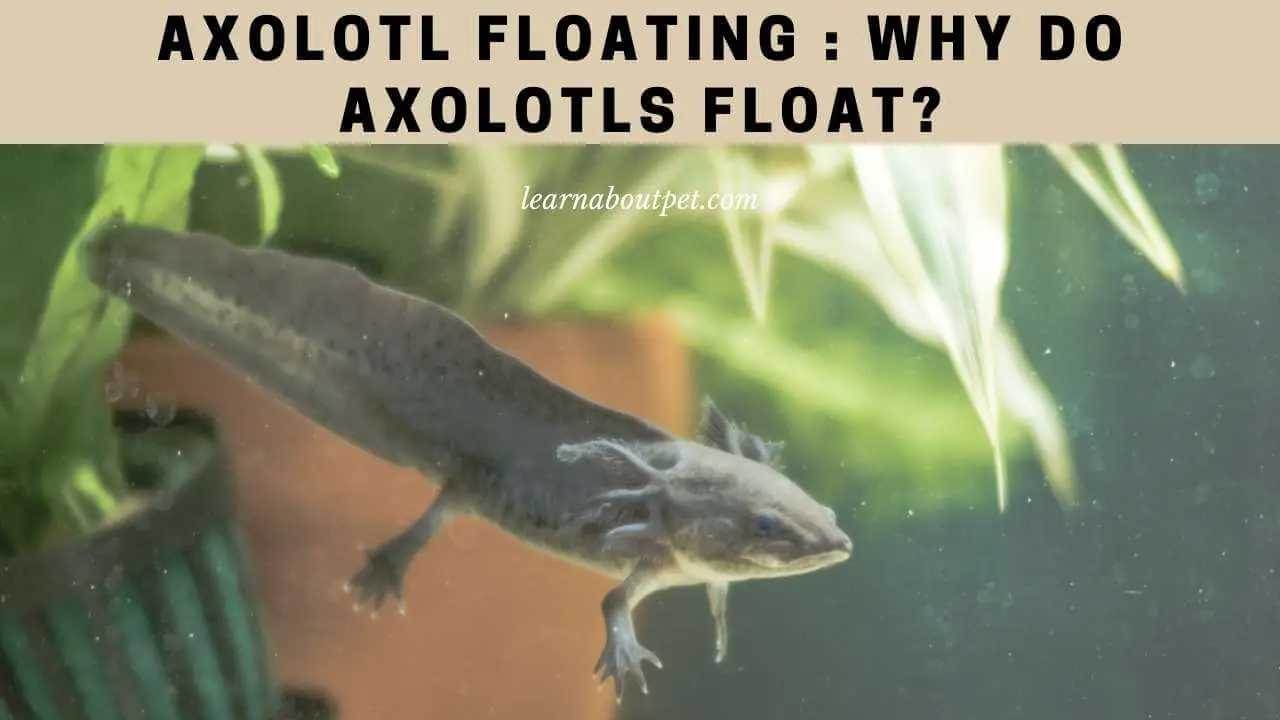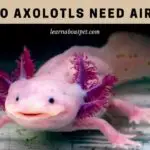Have you ever seen an Axolotl floating in a tank, and you were confused about what to do? If you see this for the first time, you will be surprised and look for ways to prevent your Axolotl from doing this. But is this normal behavior or something that should be stopped?
Why do axolotls float? Axolotls don’t usually float around because they are bottom dwellers. If you notice your Axolotl floating more often and doesn’t return to the ground, there’s a good chance that your Axolotl is facing health issue with gas build-up, ammonia spike, impaction, or swallowing air.
To learn exactly why is my Axolotl floating, let’s read this article to the end.

Why Are My Axolotls Floating?
Probably the most common Axolotl float because they have gas or bloating. Axolotl bloat can occur due to swallowing bubbles. This can happen when axolotls are frightened from the water surface and return to the water too quickly to accidentally swallow air bubbles.
Axolotl floating can also be caused by sinking pellets that have absorbed too much water and are eaten by the Axolotl. You can remove the pellets before it happens so that your Axolotl doesn’t float or bloat.
Do Axolotls Like To Float?
Axolotl floating is not normal behavior and is not done on purpose. You have to find out why is my axolotl floating, because the cause can be various things.
If you see too many pellets floating because the Axolotl doesn’t want to eat, remove it from the tank immediately, so the Axolotl doesn’t eat it when it sinks. Axolotl cannot be said to float because that is also a condition that Axolotl itself cannot overcome.
If an axolotl floats for fun, it can’t return to the ground for some time and could cause them pain due to their silly activity.
Why Do Baby Axolotls Float?
If you have baby axolotls in the tank and notice something strange about them because they are not grounded, of course, you will ask, “why is my baby axolotl floating?” Baby axolotl floating can be due to high temperatures or ammonia that appears in the tank.
For high temperatures, not only baby axolotls can’t stand it, but all axolotls can’t live with temperatures above 22°C. As for ammonia, the baby axolotl is more sensitive to the appearance of ammonia in the tank and is the main reason why is my baby axolotl floating.
Axolotl floating can be a concern if young because they are more susceptible to disease and have lower body resistance than adult axolotls.
Do Axolotls Sink Or Float When Dead?
If your Axolotl just died, then their body will sink until a day or two before the body floats into the surface. Axolotl floating on the surface can occur due to ammonia poisoning or poor water quality.
Do axolotls float when dead? Yes, after a few days, it will float into the surface, and your tank will smell because the axolotl body will decay.
If you see Axolotl floating, make sure it is still moving even though it is not so active when floating. This is to ensure that the Axolotl is still alive.
Axolotl Can’t Stop Floating – Why?
If your Axolotl can’t stop floating, there may be a problem with your water quality. Check whether the water in the tank contains ammonia or is too dirty due to axolotl waste.
If the Axolotl is in a dirty tank, they can be stressed due to poor water conditions, and they can’t stand being under the tank, so Axolotl floating and not eating will occur.
If the Axolotl floating only temporarily and they swim back into the water, it won’t be a big problem. But it will be a problem if the Axolotl keeps doing that, and you don’t find the point of the problem until the Axolotl gets sick.
How Do I Get My Axolotl To Stop Floating?
Because several factors can cause why do axolotls float, we must also study some of these conditions and how to handle them. The table below will explain Axolotl floating and how to stop it.
| Floating problems | How to prevent? |
| Overfeed or eating sinking pellets | Do not give axolotl for a few days so that the digestive system works extra until the bloat is gone. |
| Water temperature is too heat | Reduce the water temperatur with aquarium fan or water chiller. |
| Ammonia in tank | Check the ammonia level in the water, and take an action if the tank has ammonia spike. |
| Having fun at surface | Get floating plants to cover the aquarium surface. |
If your Axolotl still can’t stop floating even though you’ve prevented some things, you need to consult a vet for your Axolotl’s behavior.
Why Is My Axolotl Floating And Not Eating?
If your Axolotl floating and not eating, there is a possibility that your Axolotl has constipation. Indigestion is due to the presence of gas which hinders the digestive system process. After the gas comes out, the Axolotl will no longer float and return to the water.
First, I was confused, why is my Axolotl floating? It turns out that because the Axolotl eats pellets that have been mixed with too much water, it triggers constipation. The Axolotl floating not for too long until they recovered and swam back into the tank.
Axolotl Floating After Eating
If you see a cell Axolotl floating after being fed, two possibilities happen. Axolotl floating after eating can be due to impaction or swallowing air while eating pellets on the tank’s surface.
Impaction can cause Axolotl floating tail up because axolotls try to expel what they ingest through feces. If you use rocks as a substrate, there is a possibility that your Axolotl ingests rocks and cannot be digested.

If they are still floating for a long time after eating, do not feed them for a few days until the floating behavior disappears. Axolotls can be uncomfortable in bloat, as too much impaction can be fatal.
Why Is My Axolotl Floating At The Top Of The Tank?
Check the ammonia level in your tank because Axolotl floating at top of tank that ingest ammonia can float because they are not comfortable in the tank. Don’t let your Axolotl be poisoned by ammonia because it can be fatal.
Also, check the cleanliness of the water. If it is quite dirty because of the Axolotl’s waste, you need to first move the Axolotl and clean the tank. Axolotl floating if they feel stressed because of the water condition.
If you have changed the water in the tank to the right temperature, reinsert the Axolotl to make sure it enjoys the new water or not. If they are comfortable, then the Axolotl floating front legs is a sign of being playful and feeling calmer with suitable water in the tank.
My Axolotl Is Floating And Not Moving – What Should I Do?
My axolotls are floating and not moving, which is my biggest concern because they are not responsive even when I touch them. I saw that the Axolotl’s body was red and immediately contacted the vet to find out what might have happened to my Axolotl.
Axolotl floating tail up and unresponsive due to impaction. After I found out that the Axolotl was affected by impaction, the cause was that the Axolotl ate other fish with hard spines. This causes the Axolotl to not digest the spine properly and leads to death.
Since knowing Axolotl floating can be caused by eating other fish with an exoskeleton, I no longer put tank mates in the same tank and leave the Axolotl alone.
Why Is My Axolotl Floating Upside Down?
This is common in juvenile axolotls because of accumulating air that leads to a distended abdomen. This will make a juvenile floating upside down. Axolotl floating upside down is less common when they are adults.
This may be due to juvenile adjustment to a higher protein diet and will decrease over time as they become accustomed to the protein diet.
They look like Axolotl floating head up, looking at the bottom of the tank, then the belly facing the aquarium cover. This is done shortly after the juvenile Axolotl has eaten. Allow the Axolotl to adapt to this, but if this persists after you feed it, consult a vet immediately.
Axolotl Floating Sideways – What Does It Mean?
Occasionally we can see Axolotl floating on the side because there is too much water swallowing when eating or playing near the water surface.
When the Axolotl floating sideways, they seem to lose their balance because they still don’t understand how to remove the swallowed air bubble. This often occurs in young axolotls, from infants to juveniles.
Axolotl floating more often because the air is swallowed and makes them gassy. The Axolotl will continue to float until the air comes out of its body after some time.
Axolotl Floating Vertically – Is He Okay?
There is also a floating vertically condition, which is almost the same if the owners ask about “why is my axolotl floating at the top of the tank.”
If they are seen to be still moving and swimming to and fro with their bodies vertically facing the top of the tank, then the Axolotl is looking for more food, or they are still hungry.
If you’re already feeding them when this happens, make sure you only feed them a little more and don’t overfeed them. If you give a normal portion even though you have given them food before, then constipation and Axolotl floating on back legs can occur because they are difficult to pass stool.
Axolotl floating vertically is normal and nothing to worry about. You can try to spread little pellets to trigger their reaction. If they eat the pellet, then it is a sign your Axolotl can still receive food.
Is It Normal For Axolotls To Float?
The Axolotl does not have normal floating behavior and is more often associated with something happening to the Axolotl. For young axolotls, this often happens when they are eating and swallowing water, so the Axolotl floating head down and try to remove the air inside their body.
What if you had an axolotl in Minecraft? Have you ever seen Axolotl floating in Minecraft? This is not really noticed in the game because the Axolotl only swims in the pool.
When there is a question about why is my Axolotl floating Minecraft, that is because Axolotl gets stuck in the top of the Lily pad.
What Does It Mean When An Axolotl Floats?
Many factors can cause axolotl floats, and most occur due to bloat and indigestion. If you see an axolotl bloated belly, you need to know what the Axolotl has eaten. They may eat something slightly larger than their body, making the food difficult to digest.
Meanwhile, indigestion can cause axolotl back end floating because axolotls have difficulty issuing poops which causes them to float and are less responsive.
Final Verdict On Axolotl Floating
Although sometimes floating is not something to worry about, we also need to maintain the condition of the Axolotl so that it remains healthy with all its conditions. It literally starts from egg care after an asexual birth to baby care to adult axolotl care. Check first if you can legally own an Axolotl in your state.

If you have a young axolotl, you will often see them floating due to swallowing water while playing on the surface of the tank, while eating and swallowing air bubbles, or eating pellets that have been sinking due to too much water.
You just need to leave this condition until the Axolotl can swim again. You can prevent this condition by giving floating plants so the axolotls don’t play on the tank surface and giving them time to eat until the bloat is gone.
Do not overfeed or overfeed axolotls to prevent impaction or constipation. This can also cause axolotl floats and can lead to death if the Axolotl itself cannot digest its food.

Welcome to Learn About Pet. My name is Rajkumar Ravichandran and I love all pets, travel, and amazing food. I write about my passion and personal experience caring for multiple pets in this blog! ❤️
Post Disclaimer
DISCLAIMER: THIS BLOG OR WEBSITE, "Learn About Pet", DOES NOT PROVIDE YOU WITH MEDICAL ADVICE AND IS NOT A SUBSTITUTE FOR MEDICAL ADVICE. ALWAYS GET IN TOUCH WITH YOUR PERSONAL VETERINARIAN AND USE INFORMATION HERE AS GENERAL ADVICE.
The information, including but not limited to, text, graphics, images and other material contained on this website are for informational purposes only. No material on this site is intended to be a substitute for professional veterinary advice, food recommendation, diagnosis, or treatment. Always seek the advice of your veterinarian or other qualified health care provider with any questions you may have regarding a medical condition or for pet food related questions.







